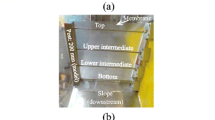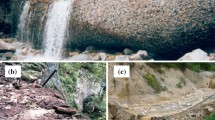Abstract
The impulse load of boulders at the front of debris flows is critical to the design of structural defense measures, which are commonly constructed on hillsides to mitigate landslide risk. Field evidences have demonstrated the capability of some steel flexible barriers in intercepting debris flows with bouldery inclusions. However, there is still a lack of fundamental understanding of the load-attenuation mechanisms of flexible barriers, especially under bouldery debris flow impact. In this study, systematic tests of mono-disperse and bi-disperse bouldery flows impacting an instrumented flexible barrier were conducted using a geotechnical centrifuge. The impact kinematics and barrier responses, such as mobilized structural forces and elongation of cables, were recorded synchronously. The results reveal that the load-attenuation mechanism of flexible barriers for the frontal impact originates from the barrier deflections and extended interaction duration. Only 30% of the frontal momentum is transferred to the flexible barrier. The performance of the flexible barrier is compared with that of a rigid barrier model under identical testing conditions. It is found that the boulder impulse loads on flexible barrier are significantly attenuated, resulting in a “plateau” pattern of the impact time history. The practical implication is that the design of flexible barriers may not demand separate considerations of the bulk debris and individual boulder impact loads. Detailed examination of the state of debris deposited behind the flexible barrier indicates that the static dry debris is close to the active failure state due to the large barrier deflection.












Similar content being viewed by others
References
Ashwood W, Hungr O (2016) Estimating the total resisting force in a flexible barrier impacted by a granular avalanche using physical and numerical modeling. Can Geotech J 53(10):1700–1717. https://doi.org/10.1139/cgj-2015-0481
Bugnion L, Wendeler C (2010) Shallow landslide full-scale experiments in combination with testing of a flexible barrier. In: Monitoring, Simulation, Prevention and Remediation of Dense and Debris Flows III, pp 161–173
Bugnion L, McArdell BW, Bartelt P, Wendeler C (2012) Measurements of hillslope debris flow impact pressure on obstacles. Landslides 9(2):179–187. https://doi.org/10.1007/s10346-011-0294-4
Chanson H (2004) Hydraulics of open channel flow. Elsevier, Amsterdam
Costa JE (1984) Physical geomorphology of debris flows. In: Developments and Applications of Geomorphology. Springer-Verlag, Berlin
Craig RF (2004) Craig's soil mechanics. CRC Press, Boca Raton
DeNatale JS, Iverson RM, Major JJ, LaHusen RG, Fiegel GL, Duffy JD (1999) Experimental testing of flexible barriers for containment of debris flows. US Department of the Interior, US Geological Survey, Reston
EOTA (2016) Flexible kits for retaining debris flows and shallow landslides/open slope debris flows. EAD340020-00-0106. https://www.eota.eu/handlers/download.ashx?filename=ead-in-ojeu%2fead-340020-00-0106-ojeu2016.pdf
Gray JMNT, Tai YC, Noelle S (2003) Shock waves, dead zones and particle-free regions in rapid granular free-surface flows. J Fluid Mech 491:161–181
Hübl J, Suda J, Proske D, Kaitna R, Scheidl C (2009) Debris flow impact estimation. In: Proceedings of the 11th International Symposium on Water Management and Hydraulic Engineering. Ohrid, Macedonia, pp 1–5
Iverson RM (2015) Scaling and design of landslide and debris-flow experiments. Geomorphology 244:9–20
Johnson CG, Kokelaar BP, Iverson RM, Logan M, LaHusen RG, Gray JMNT (2012) Grain-size segregation and levee formation in geophysical mass flows. J Geophys Res: Earth Surf 117(F1)
Koo RCH, Kwan JSH, Ng CWW, Lam C, Song D, Pun WK (2016) Velocity attenuation of debris flows and a new momentum-based load model for rigid barriers. Landslides. 14(2):617–629. https://doi.org/10.1007/s10346-016-0715-5
Kwan JSH (2012) Supplementary technical guidance on design of rigid debris-resisting barriers. GEO Report No. 270. Geotechnical Engineering Office, HKSAR Government
Kwan JSH, Cheung RWM (2012) Suggestion on design approaches for flexible debris-resisting barriers. Discussion note DN1/2012. Geotechnical Engineering Office, HKSAR Government
Kwan JSH, Sze EHY, Lam C (2018) Finite element analysis for rockfall and debris flow mitigation works. Can Geotech J. https://doi.org/10.1139/cgj-2017-0628
Mavrouli O, Corominas J (2010) Vulnerability of simple reinforced concrete buildings to damage by rockfalls. Landslides 7(2):169–180
McArdell BW, Bartelt P, Kowalski J (2007) Field observations of basal forces and fluid pore pressure in a debris flow. Geophys Res Lett 34(7). https://doi.org/10.1029/2006GL029183
Ng CWW (2014) The state-of-the-art centrifuge modelling of geotechnical problems at HKUST. J Zhejiang Univ SCIENCE A 15(1):1–21
Ng CWW, Song D, Choi CE, Koo RCH, Kwan JSH (2016) A novel flexible barrier for landslide impact in centrifuge. Géotechnique Lett 6(3):221–225
Ng CWW, Su Y, Choi CE, Song D, Lam C, Kwan JSH, Chen R, Liu H (2018) Comparison of cushioning mechanisms between cellular glass and gabions subjected to successive boulder impacts. J Geotech Geoenviron 144(9):04018058
Sasiharan N, Muhunthan B, Badger TC, Shu S, Carradine DM (2006) Numerical analysis of the performance of wire mesh and cable net rockfall protection systems. Eng Geol 88(1):121–132
Savage SB (1984) The mechanics of rapid granular flows. Adv Appl Mech 24:289–366
Savage SB, Hutter K (1989) The motion of a finite mass of granular material down a rough incline. J Fluid Mech 199:177–215
Schofield AN (1980) Cambridge geotechnical centrifuge operations. Geotechnique 30(3):227–268
Song D, Ng CWW, Choi CE, Zhou GGD, Kwan JSH, Koo RCH (2017) Influence of debris flow solid fraction on rigid barrier impact. Can Geotech J 54: 1421–1434
Song D, Choi CE, Zhou GGD, Kwan JSH, Sze HY (2018a) Impulse load characteristics of bouldery debris flow impact. Géotechnique Lett 8(2):111–117
Song D, Choi CE, Ng CWW, Zhou GGD (2018b) Geophysical flows impacting a flexible barrier: effects of solid-fluid interaction. Landslides 15(1):99–110
Sze EHY, Koo RCH, Leung JMY, Ho KSS (2018) Design of flexible barriers against sizeable landslides in Hong Kong. HKIE Trans 25(2):115–128
T/CAGHP (2018) Specification of design for debris flow prevention. 021–2018. China University of Geosciences Press, Beijing
Taylor RN (1995) Geotechnical centrifuge technology. Blackie Academic Professional, Glasgow, U.K.
Wendeler C, McArdell BW, Rickenmann D, Volkwein A, Roth A, Denk M (2006) Field testing and numerical modeling of flexible debris flow barriers. In: Proceedings of international conference on physical modelling in geotechnics, Hong Kong
Wendeler C, Volkwein A, McArdell BW, Bartelt P (2019) Load model for designing flexible steel barriers for debris flow mitigation. Can Geotech J 56(6):893-910.https://doi.org/10.1139/cgj-2016-0157
WSL (2009) Full-scale testing and dimensioning of flexible debris flow barriers. In: Technical report 1–22. WSL, Birmensdorf
Yong ACY, Lam C, Lam NT, Perera JS, Kwan JSH (2019) Analytical solution for estimating sliding displacement of rigid barriers subjected to boulder impact. J Eng Mech 145(3):04019006
Zeng C, Cui P, Su Z, Lei Y, Chen R (2015) Failure modes of reinforced concrete columns of buildings under debris flow impact. Landslides 12(3):561–571
Funding
This study was financially supported by the National Natural Science Foundation of China (grant nos. 51809261, 11672318, and 51709052), by a research grant (T22-603/15-N) provided by the Research Grants Council of the Government of Hong Kong SAR, China. This paper is published with the permission of the Head of the Geotechnical Engineering Office and the Director of Civil Engineering and Development, the Government of the Hong Kong SAR, China. The support by the Geotechnical Engineering Office is gratefully acknowledged.
Author information
Authors and Affiliations
Corresponding author
Rights and permissions
About this article
Cite this article
Song, D., Choi, C.E., Ng, C.W.W. et al. Load-attenuation mechanisms of flexible barrier subjected to bouldery debris flow impact. Landslides 16, 2321–2334 (2019). https://doi.org/10.1007/s10346-019-01243-2
Received:
Accepted:
Published:
Issue Date:
DOI: https://doi.org/10.1007/s10346-019-01243-2




